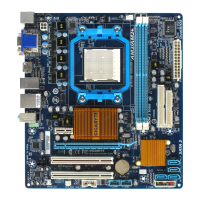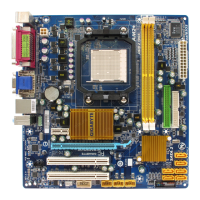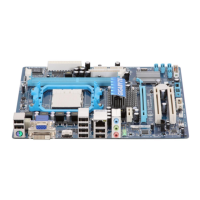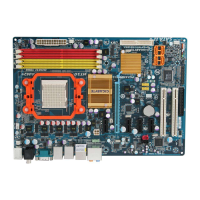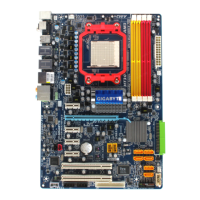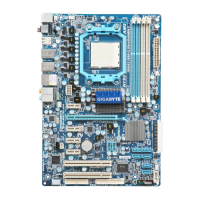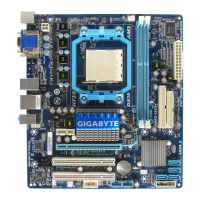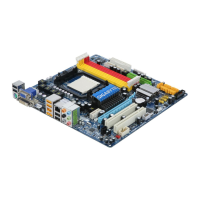Do you have a question about the Gigabyte GA-MA74GMT-S2 and is the answer not in the manual?
Essential safety guidelines and procedures to follow before installing hardware components.
Detailed technical specifications of the motherboard, including chipset, memory, and connectivity.
Step-by-step instructions for correctly installing the CPU and its associated cooler.
Guidance on installing memory modules, including dual-channel configuration.
Instructions for installing expansion cards into available slots on the motherboard.
Identification and function of all connectors located on the motherboard's back panel.
Details and pin assignments for various internal headers and connectors on the motherboard.
Description of the screens that may appear during the computer's boot process.
Explanation of how to navigate the main BIOS setup menu and use function keys.
Advanced settings for CPU, memory clock, frequency, and voltages for performance tuning.
Configuration of system date, time, and IDE/SATA drive parameters.
Settings for boot order, virtualization, security, and display options.
Enabling or disabling onboard devices like IDE, SATA, LAN, and audio controllers.
Configuration options for system sleep states, wake-up events, and power button behavior.
Settings for Plug and Play (PnP) and PCI slot IRQ assignments.
Monitoring system temperatures, voltages, fan speeds, and case intrusion status.
Restores the BIOS to the most stable, minimal-performance default settings.
Restores the BIOS to factory settings for optimal system performance.
Setting supervisor or user passwords to protect BIOS setup access and system.
Procedure for saving modified BIOS settings and exiting the setup utility.
How to exit the BIOS setup without applying any changes made.
Instructions for installing the essential chipset drivers for motherboard functionality.
Guide to installing GIGABYTE's software utilities and other bundled applications.
Information on how to access application guides, driver disk contents, and motherboard manuals.
Contact details for GIGABYTE's headquarters and branch offices for support.
How to view basic system information such as motherboard, BIOS, and CPU details.
Link to GIGABYTE's website for downloading the latest BIOS, drivers, and applications.
Utility for compressing, backing up, and restoring system data using file system support.
Instructions for updating the system BIOS using GIGABYTE's Q-Flash and @BIOS utilities.
Software for fine-tuning system settings, overclocking, and monitoring hardware in Windows.
Tool for sharing data with other computers on the network via LAN connection.
Utility for backing up and restoring system data using Microsoft Volume Shadow Copy Services.
Steps for installing SATA drives, configuring controller mode, and setting up RAID arrays.
Guides on configuring multi-channel audio, S/PDIF, microphone recording, and sound effects.
FAQs and a troubleshooting procedure to diagnose and resolve system startup problems.
Information on regulatory notices, environmental directives (RoHS, WEEE), and safety statements.
Essential safety guidelines and procedures to follow before installing hardware components.
Detailed technical specifications of the motherboard, including chipset, memory, and connectivity.
Step-by-step instructions for correctly installing the CPU and its associated cooler.
Guidance on installing memory modules, including dual-channel configuration.
Instructions for installing expansion cards into available slots on the motherboard.
Identification and function of all connectors located on the motherboard's back panel.
Details and pin assignments for various internal headers and connectors on the motherboard.
Description of the screens that may appear during the computer's boot process.
Explanation of how to navigate the main BIOS setup menu and use function keys.
Advanced settings for CPU, memory clock, frequency, and voltages for performance tuning.
Configuration of system date, time, and IDE/SATA drive parameters.
Settings for boot order, virtualization, security, and display options.
Enabling or disabling onboard devices like IDE, SATA, LAN, and audio controllers.
Configuration options for system sleep states, wake-up events, and power button behavior.
Settings for Plug and Play (PnP) and PCI slot IRQ assignments.
Monitoring system temperatures, voltages, fan speeds, and case intrusion status.
Restores the BIOS to the most stable, minimal-performance default settings.
Restores the BIOS to factory settings for optimal system performance.
Setting supervisor or user passwords to protect BIOS setup access and system.
Procedure for saving modified BIOS settings and exiting the setup utility.
How to exit the BIOS setup without applying any changes made.
Instructions for installing the essential chipset drivers for motherboard functionality.
Guide to installing GIGABYTE's software utilities and other bundled applications.
Information on how to access application guides, driver disk contents, and motherboard manuals.
Contact details for GIGABYTE's headquarters and branch offices for support.
How to view basic system information such as motherboard, BIOS, and CPU details.
Link to GIGABYTE's website for downloading the latest BIOS, drivers, and applications.
Utility for compressing, backing up, and restoring system data using file system support.
Instructions for updating the system BIOS using GIGABYTE's Q-Flash and @BIOS utilities.
Software for fine-tuning system settings, overclocking, and monitoring hardware in Windows.
Tool for sharing data with other computers on the network via LAN connection.
Utility for backing up and restoring system data using Microsoft Volume Shadow Copy Services.
Steps for installing SATA drives, configuring controller mode, and setting up RAID arrays.
Guides on configuring multi-channel audio, S/PDIF, microphone recording, and sound effects.
FAQs and a troubleshooting procedure to diagnose and resolve system startup problems.
Information on regulatory notices, environmental directives (RoHS, WEEE), and safety statements.
| Non-ECC | Yes |
|---|---|
| Memory voltage | 1.5 V |
| Number of memory slots | 2 |
| Processor socket | Socket AM3 |
| Processor manufacturer | AMD |
| Number of SATA connectors | 4 |
| Number of Parallel ATA connectors | 1 |
| Headphone outputs | 3 |
| USB 2.0 ports quantity | 8 |
| Firewire (IEEE 1394) ports | 0 |
| Audio chip | Realtek ALC888B |
| Power source type | ATX |
| Motherboard chipset | AMD 740G |
| Audio output channels | 7.1 channels |
| Motherboard form factor | micro ATX |
| Compatible operating systems | Win 7, Vista, XP |
| RAID levels | 0, 1 |
| Bundled software | Norton Internet Security |
| Networking features | 10/100/1000 Mbps |
| BIOS memory size | 16 Mbit |
| Depth | 220 mm |
|---|---|
| Width | 244 mm |
